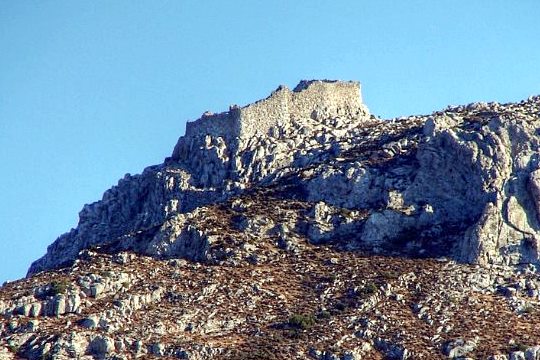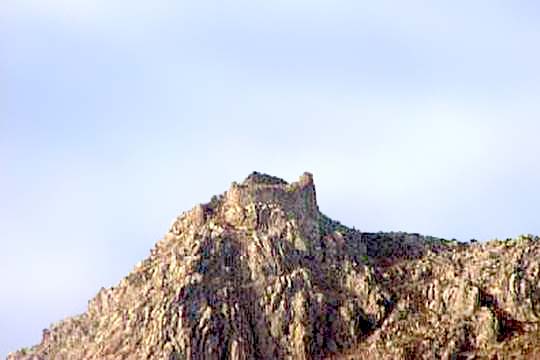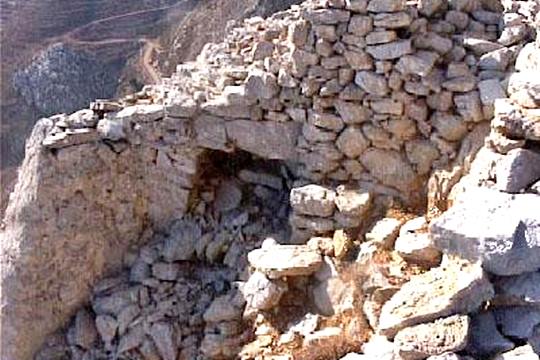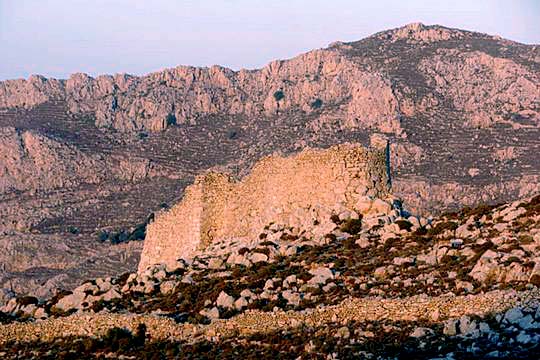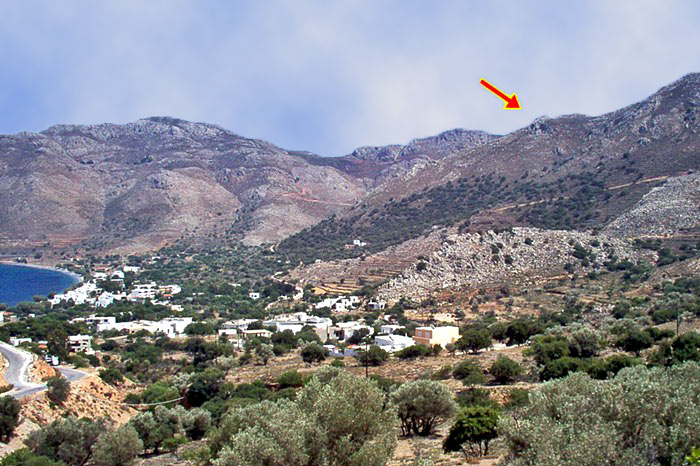Livadia, Tilos, Dodecanese,South Aegean
Agriosykia Castle
| Location: |
| Livadia, Tilos island, Dodecanese |
| Region > Prefecture: | 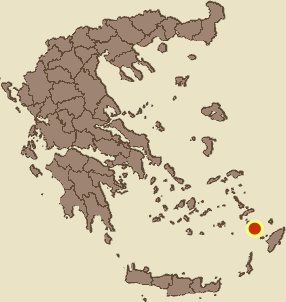 |
| South Aegean Dodecanese | |
| Municipality > Town: | |
| City of Tilos • Livadia | |
| Altitude: | |
| Elevation ≈ 270 m |
| Time of Construction | Origin | |
| 15th century | IOANNITE |
|
| Castle Type | Condition | |
| Castle |
Rather Poor
|
Most probably a Byzantine castle on a steep mountain; used during the Knights Hospitallers‘ reign.
Castle Description
Text: Dr. Michael Losse – Singen (Hohentwiel), Germany (05.12.2021)General Description
The Kastro Agriosykia (meaning "Castle to the Wild Fig Tree", cf. Lehmann 1985, pp. 268-269) stands on a steep limestone spur that protrudes to the north-northeast south above the harbour bay of Livadia. The spur is inaccessible on two sides because of its steep slopes.
The statement of Ingeborg Lehmann (1985, p. 268) that the castle’s walls have “the same color as the mountain on which they stand, so that most visitors do not notice the remains”, also applies to other castles on Tilos (Faneromeni; Stavros; Palaiokastro) and other Dodecanese islands.
From the castle there is visual contact with the Kastro Faneromeni in the southeast of the bay of Livadia, with the abandoned village of Mikro Chorio with its castle and with the mountain with the radio masts of the O.T.E. north of the Kastro tou Lambrou. The islands of Symi and Kos are also visible from here.
The access to the castle is on the north side of the spur above the abyss; the path led in a ramp partly provided with stairs over a bricked gap or a hollow (cf. Kastro tou Lambrou ). However, at Agriosykia castle there was an apparently later created, today largely abandoned barbican protecting the gate (similar to the castles Mesaria and Mikro Chorio on Tilos), which, however, does not appear in published layout plans. Such barbicans were widespread in the final phase of the Knights Hospitallers‘ rule (late 15th/early 16th centuries) at the Order’s castles and fortifications on the Dodecanese.
The access to the interior of the castle is, today only accessible under danger, on the steeply sloping side, withdrawn in a stepping section of the wall and was thus flanked better to defend. The simple wall gate is heavily destroyed and filled with collapse from the inside, so that the castle can only be entered today via the partially collapsed wall to the right of the gate and the collapse dump in front of it.
The enceinte is performed in coarse dry masonry made of limestone quarry stones of different formats and follows, irregularly jumping in and out, the rock edge of the spur. It seems as if the wall was (later?) covered with mortar or plastered. It is possible that the enceinte wall was set in clay mortar, which is now largely weathered, as well as the aforementioned plaster or mortar coating in the upper areas of the heavily dilapidated wall there. Because of the heavy destruction, there is no knowledge about the wall crown, battlements, etc. Loopholes are not visible in the preserved parts of the wall.
Inside the castle there is almost all of the fallen masonry; among them are partly cavities (building remains) visible, as well as remains of buildings in mortar masonry, whose function can no longer be recognized due to the heavy destruction. A chapel or a cistern is said to have been located behind the enceinte‘s section protruding in tongues to the saddle (Koutelakis, p. 54; cf. layout plan ibd.).
Access
Free access. – The castle can be reached on sight via footpaths and driving paths from Livadia, but the visit is dangerous. The access ramp running along the steep slope has partly erupted, the gate construction has collapsed. A visit of the castle’s interior, which is covered by wall collapse, is very dangerous! Caution: Scorpions!
History of the castle
Because not all statements of medieval and early modern written sources can be obtained from certain castles on the island of Tilos, a more detailed historical overview of warlike events in the late Middle Ages is given here:
From the 8th to the 14th century, hardly any data and facts from the history of the island are known, except for the fact that Tilos (like Nisyros and Kos) belonged to the Thema (= Byzantine military district) of Samos. Since 1309 (cf. Gerola 1914, p. 171; Koutelakis, p. 12) or 1310 (cf. Kollias 1976, p. 203) Tilos was in the possession of the Chivalric Order of St. John, which later owned a large number of castles here (cf. Dawkins/Wace 1905/06, pp. 163-164f: “Telos is comparatively rich in mediaeval castles”).
When the Order feared attacks in 1475 and 1480, there were plans to evacuate the inhabitants of the island of Tilos to Rhodes. In 1479, 1485 and 1505 there were attacks on Tilos, which is said to have come under Ottoman rule before the conquest of Rhodes (1522) (Hasluck 1910-11, p. 166).
From the time of the Knights Hospitallers‘ rule over Tilos some historical events, although not in all details, are known, which are presented in the literature partly contradictory. While research had previously assumed that Tilos had been uninhabited for a long time in the Middle Ages, recent studies have led to the thesis that there had been “local powers” since the early 13th century, which the Order respected (Koutelakis, p. 12, with reference to research by Tsirpanlis).
From 1366 it is reported that Barrello Assanti of Ischia, borghese ("citizen") of Rhodes, had taken the islands of Chalki and Tilos as fiefs (in feudo) in May of that year (Bosio 1695, II, p. 105).
In 1433 (?) corsairs from Alexandria attacked Tilos and other Dodecanese islands, and in 1444 the Knights of St. John Guido di Domaigne and Ettore d'Alemagna came to Tilos to take measures to re-fortify or strengthen castles (Koutelakis, p. 14). The 2nd half of the 15th century was the most belligerent phase in the history of Tilos and the entire monastic state. In 1457, Turks devastated Tilos, they cut trees and robbed cattle after failing to capture one of the castles (Koutelakis, p. 14).
The islands of Kalymnos, Leros and Nisyros also suffered from raids around this time; the inhabitants of some islands were evacuated to Rhodes (Kollias 1988, p. 16), including people from Tilos, "because defence proved weak and food was insufficient" (Koutelakis, p. 14). The Telians apparently had a fixed defensive section on the city fortifications of Rhodes (this was told to me by Dr. Ilias Kollias). The evacuations of entire island populations to Rhódos probably served not only to protect these people, but rather to strengthen the defenders of the fortress city.
In 1479 there was an attack that was often referred to as a Turkish attack (cf. Gerola 1916, p. 14; Kolias 1976, p. 203; Spiteri 1994, p. 172; Spiteri 2001, p. 166). On the other hand, Dawkins/Wace (1905-06, p. 165) report that Bacha Palaiologos, the second son of the last despot of Morea, Thomas, and nephew of the last Byzantine emperor Constantine XI, attacked Tilos. This led to a fight for an unnamed castle, in which breaches were placed, but which could not be conquered (Dawkins/Wace 1905-06, p. 165, note 3: “he breached the walls, failed to take it”, with reference to Vertot: Histoire des Chevaliers Hospitaliers, ii, p. 397).
In Koutelakis‘ book (p. 14), the story of the attack reads as follows: “In 1479 the Turks landed on the island to destroy the village, steal animals and defame the knights of Rhodes to the Telians. But the[y] rushed out suddenly and killed all but one who was sent to Rhodes. In December 1479 there was another Turkish attack and siege of the castle for 8 days without success.”
In 1485 the island is said to have been attacked again (Kollias 1990, p. 203), and in 1505 the corsair Camali made an attempt to conquer Tilos (Dawkins/Wace 1905-06, p. 165, note 4, refer to Vertot ii, p. 301). Camali (= Kemali-Reisi) also attacked the Kastro via Platanos on the island of Leros in 1506.
Agriosykia Castle is intended to be used by residents of surrounding settlements (Anastoristos; Roukouni; possibly Gera) as a refuge in times of danger. It was built in the 15th century, according to the archaeologist Koutelakis (p. 20). Written sources on the construction and history of the castle are apparently not known. However, the foundation of the castle in Byzantine times is not unlikely.
Other Info
SourcesDawkins, R. M./Wace, Alan J. B.: Notes from the Sporades, Astypalaea, Telos, Nisyros, Leros. In: BSA XII, 1905-1906, pp. 151-174.
Gerola, Giuseppe: I monumenti medioevali delle 13 Sporadi. In: Annuario della Scuola Archeologica di Atene e delle Missioni Italiane in Oriente, Vol. II, 1916, pp. 29-54.
Hasluck, F. W.: Depopulation in the Aegean Islands and the Turkish Conquest. In: BSA, No. XVII, Session 1910-1911, pp. 151-181.
Kollias, Elias: Telos (Tilos). In: Evi Melas (Ed.): Die griechischen Inseln. Köln (Germany) 1976, pp. 202-205 (121994).
Kollias, Elias: The City of Rhodes and the Palace of the Grand Master. Athens 1988.
Kollias, Elias: The Knights of Rhodes. Athens 1991.
Koutelakis, Haris M.: Tilos. Art, History, Archaeology. Athen (without specifying the year of publication).
Lehmann, Ingeborg: Die Dodekanes (Griechische Inseln, Vol. 3). Leichlingen bei Köln (Germany) 1985.
Losse, Michael: Burgen und Befestigungen des Johanniter-Ordens auf den Dodekanes-Inseln Tílos, Chálki und Alimiá (Teil 1). In: Burgenforschung aus Sachsen (Editor: Heinz Müller, Deutsche Burgenvereinigung, Landesgruppe Sachsen), Vol. 17/2, 2004, pp. 98-129; Vol. 18/2, 2005, pp. 135-157.
Losse, Michael: Die Burgen und Festungen des Johanniter-Ritterordens auf Rhódos und in der Ägäis (Griechenland) 1307-1522. (Publisher: Nünnerich-Asmus Verlag) Mainz 2017.
Losse, Michael: Burg und Expansion in der Südost-Ägäis: Von den byzantinischen Befestigungen der „Dunklen Jahrhunderte“ (7.-10. Jahrhundert) bis zu den Invasionen der „Franken“ (13./14. Jahrhundert) und Osmanen (15./16. Jahrhundert). In: Joachim Zeune (Ed.)/Christof Krauskopf: Burg und Expansion. Kolloquium des Wissenschaftlichen Beirats des Deutschen Burgenvereinigung Brandenburg 2019 (Veröffentlichungen der Deutschen Burgenvereinigung e. V. Herausgegeben vom Europäischen Burgeninstitut – Einrichtung der Deutschen Burgenvereinigung. Reihe B: Schriften, Bd. 18; zugleich Arbeitsberichte zur Bodendenkmalpflege in Brandenburg, Bd. 36, hrsg. von Franz Schopper). Braubach 2021, pp. 107-124.
Loupou-Rokou, Athena-Christina: The Aegean Fortresses and Castles. Athens 1999, pp. 76-77.
Spiteri, Stephen C.: Fortresses of the Cross. Hospitaller Military Architecture (1136-1798). Valletta (Malta) 1994.
Spiteri, Stephen C.: Fortresses of the Knights. Ħamrun (Malta) 2001.
| First entry in Kastrologos: | November 2012 | Last update of info and text: | January 2022 | Last addition of photo/video: | January 2022 |
Sources
- Photos 1,6,7,8,10 (2008) and article (Dec 2021) by Dr. Michael Losse
|
|
| Access |
|---|
| Approach to the monument: |
| It can be reached on sight via footpaths and driving paths from Livadia, but the visit is dangerous. The access ramp running along the steep slope has partly erupted, the gate construction has collapsed. |
| Entrance: |
| Free access |



